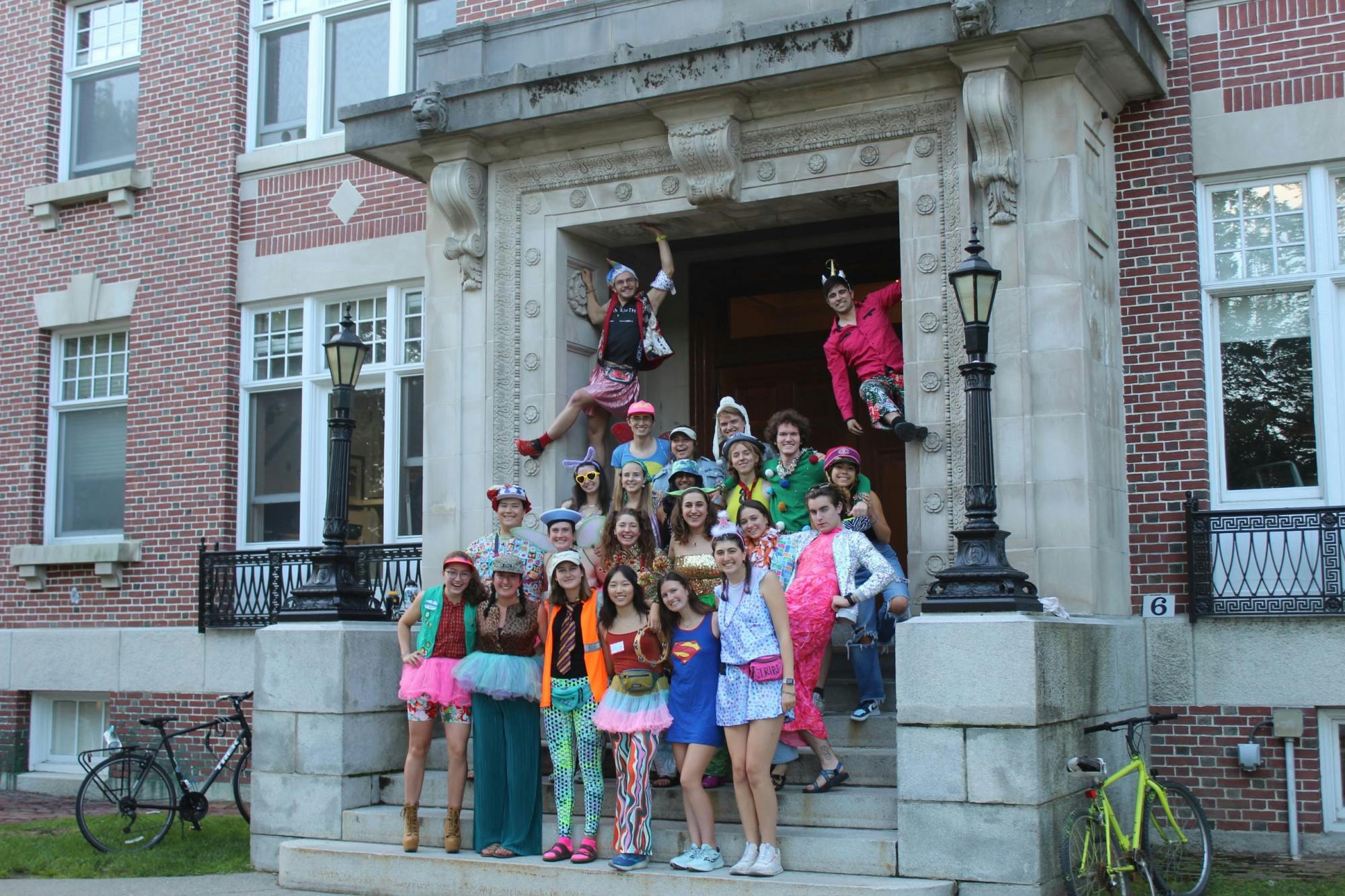At an Ivy League college, it’s expected that students are stoically academic — laser-focused on their school work, careers and 10-year plans. And, although Dartmouth students are no exception, they can also be quirky. The same students that spend hours in the library also deck themselves out in neon tutus, fairy wings, glittery tops and 2010-esque leggings, dancing their hearts out in front of Robinson Hall during First-Year Trips.
For many ’27s, Trips was the first time they truly experienced “flair,” Dartmouth’s term for loud, silly, brightly-colored clothing.
Miles Brokenleg ’27 recalled being taken aback when he first saw Hanover Croo decked out in flair in front of Robo during Trips.
“Wow,” he remembered thinking. “These people are crazy … [they’re] just so out there.”
Carolina Splawn ’27 was also initially taken aback by the sight.
“What is this school?” she recalled thinking. “Where am I? Why am I here? Who are these people?”
As such, even in their short time here, the ’27s have already grown to see how much the Dartmouth community thrives on authenticity and self-expression.
“I think it’s cool now,” Splawn explained. “It’s a way to not care what other people think and wear the most random things.”
Kathy Jia ’27 also expressed appreciation for the unique tradition, citing how flair reminded her that, despite Dartmouth’s academic intensity, students still enjoy expressing their individuality.
“[Ivy League schools] are super intense academically, and it’s very hard to see people as people, especially when you know you’re competing against them … [for] good grades or internship spots,” Jia said. “Flair is one of those many things that … really helps connect the students to each other.”
Reflecting similarly on her freshman year experience with flair, Alannah McShine ’25 agreed with Jia.
“We may be very academically-oriented students, but we also know that it’s important to have fun [with our clothing] and take a break from those academics,” she said. “It was something good to see as a freshman.”
However, McShine also acknowledged that wearing flair requires some “social bravery.” Walking around in an absurdly flashy outfit can be daunting at first, especially around tour groups. However, this fear of judgment is short-lived when students embrace flair together.
“When everyone puts on flair, no one really cares about what other people think,” she said.
Although flair is such an integral and common part of campus, witnessing people dressed in their most outlandish clothing is always a fun, new experience.
“The wonder of flair is [that] it’s ... so spontaneous, so fun and you can’t expect it,” Jia said. “Sometimes [when] I run to [swim] practice in the morning … there’s just a group of [10 to 15] people … all dressed in flair, and they’re just hanging out. I don’t know what they’re there for, but it’s absolutely amazing.”
Due to its quick embrace by the freshman class, some ’27s have already worn flair themselves — mostly through clubs that encourage their members to wear flair as a means of bonding.
Jia recalled wearing flair at a restaurant with the swim team. “I think I wore a Hello Kitty sweater, a hiking hat, blue sunglasses, one turkey leg sock, one Kirby sock and a super reflective, gray skirt,” she said. “The process of wearing flair, then going out into the regular public, is a feeling of empowerment.”
Brokenleg had a similar experience with his a cappella group, The Dartmouth Sings, after upperclassmen members texted him to wear flair before going out to dinner. Wearing flair himself, instead of watching from afar, marked a pivotal point for his sense of belonging at Dartmouth.
“Actually participating in [flair] and just having fun with it was a really nice experience for me because it made me feel like a part of [the] Dartmouth community,” Brokenleg said. “It went from being like …‘Ha ha that’s funny they’re wearing it’ to ‘Oh, ha ha, I’m the one wearing it.’”
Freshmen have already started to acquire wacky items of clothing to wear themselves. Although Brokenleg borrowed his flair from generous friends, the clothing pieces he donned will hold memories that live on far beyond the short moments of when they were worn.
“Even though I had to give all those pieces back to my friends, they’ll always remember, ‘Oh remember that day that Miles had to wear flair and go take pictures with all his professors?’ and we’ll go back and look at pictures [from that day],” he said.
Although the majority of ’27s are just starting to build their flair collection, many upperclassmen, like McShine, have already garnered a sizable amount of flair, whether through clubs, costumes from home or bequests from upperclassmen.
“I have a little bag of it growing,” McShine said. “I’m sure ’27s will start [their] own collections soon.”
Regardless of how large someone’s collection may be, as ’27s get more settled into campus, flair is more than just sparkly, awkwardly-layered outfits. It’s a way for people to express themselves to the extremes, to know that Dartmouth is one of the only places where it is not only normal, but encouraged, to be as extravagantly “you” as possible. Flair represents Dartmouth culture at its core: No matter how wacky or out-of-place you feel, there will always be people who embrace your weirdness.
“Flair just goes to show [that] you can be yourself,” Brokenleg said. “You can be the crazy personality that you want to be.”




